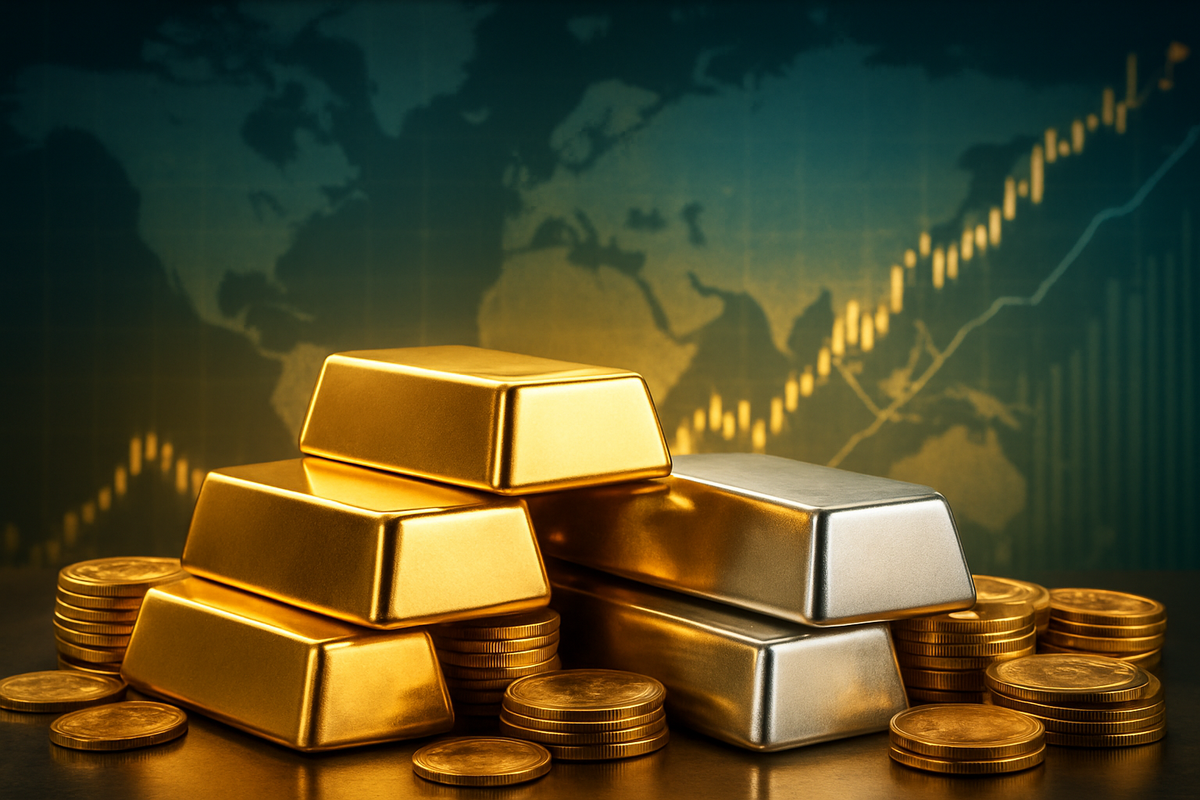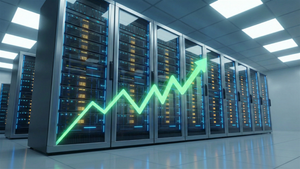
2025 has cemented its place as a landmark year for precious metals, with gold leading a spectacular rally that has seen its value soar to unprecedented heights. This robust performance, fueled by a complex interplay of global economic uncertainties, persistent geopolitical tensions, and strategic shifts in central bank policies, has ignited renewed interest in the entire precious metals complex. As gold maintains its commanding position, analysts are increasingly bullish on the prospects for other metals like silver and platinum, predicting even greater surges in the coming months and years. This resurgence signals a significant recalibration of investor sentiment, highlighting a collective turn towards tangible assets amidst a volatile financial landscape.
The immediate implications of this precious metals boom are far-reaching. Investors are flocking to these traditional safe havens, diversifying portfolios and seeking refuge from inflationary pressures and currency devaluations. The mining sector is experiencing a renaissance, with increased profitability driving exploration and expansion. However, industries heavily reliant on precious metals as raw materials, such as electronics and automotive, are bracing for significant cost pressures, potentially reshaping their operational strategies and product pricing.
Gold's Unprecedented Ascent and the Broadening Precious Metals Rally
Gold's performance in 2025 has been nothing short of extraordinary. The yellow metal surged by approximately 60% year-to-date, surpassing $4,000 per ounce by October and even briefly touching above $4,300 before consolidating. This meteoric rise has been underpinned by several critical factors. Geopolitical tensions, including ongoing global conflicts and trade disputes, have significantly amplified gold's appeal as a safe-haven asset. Simultaneously, a weakening US dollar has made gold more attractive to international buyers, while persistent inflation concerns have driven investors to gold as a hedge against eroding purchasing power.
Central banks, particularly those in nations like China, Russia, India, and Turkey, have been robust net buyers, diversifying their reserves away from the US dollar and signaling concerns about currency stability. Expectations of central bank interest rate cuts throughout 2025 have further lowered the opportunity cost of holding non-yielding gold, enhancing its allure. Concerns over rising US government debt and potential shutdowns have also pushed investors towards safe-haven assets. This confluence of factors has not only propelled gold but has also set the stage for other precious metals.
Silver has mirrored gold's strong showing, with its spot price reaching $52.45 per ounce by October 2025, more than doubling its value from a year prior. Analysts are overwhelmingly bullish on silver, projecting further returns and potential all-time highs. This optimism stems from growing industrial demand, especially in green technologies like solar panels and electric vehicles, which account for a significant portion of its annual consumption. Consistent supply deficits since 2021 are also expected to continue, contributing to inventory depletion and favoring price appreciation.
Platinum, while lagging behind gold and silver in recent years, has also demonstrated strong performance, ending the first half of 2025 above $1,400 per ounce. It is forecast to remain in a supply deficit for the third consecutive year, driven by automotive demand (autocatalysts), increasing investment demand, and rising jewelry and industrial applications. Palladium, in contrast, faces a more challenging outlook despite a recovery to around $1,427.21 by November. Its heavy reliance on the auto sector and the trend of substitution by cheaper platinum, coupled with the increasing adoption of electric vehicles, present significant headwinds, though potential sanctions on Russian supply could offer an upside.
Corporate Fortunes: Winners and Losers in the Precious Metals Boom
The surge in precious metals prices in 2025 is creating a clear divide between companies poised to win and those facing significant challenges.
The Winners: Mining and Streaming Companies
Mining companies, particularly those focused on gold, silver, and Platinum Group Metals (PGMs), are the primary beneficiaries. Higher metal prices directly translate to increased revenues and expanded profit margins, boosting cash flows and often leading to higher dividend payouts and greater investment in exploration and operational improvements.
- Gold Miners: Major players like Newmont Corporation (NYSE: NEM), the world's largest gold producer, and Barrick Gold Corporation (NYSE: GOLD), known for its "Tier One" assets, are seeing substantial gains. Other significant beneficiaries include Agnico Eagle Mines (NYSE: AEM), AngloGold Ashanti (NYSE: AU), Alamos Gold (NYSE: AGI), Gold Fields (JSE: GFI), and Kinross Gold (NYSE: KGC).
- Silver Miners: Companies such as Fresnillo Plc (LSE: FRES), the world's largest primary silver producer, and Pan American Silver Corp. (NASDAQ: PAAS) are set to gain immensely from increased profitability. First Majestic Silver Corp. (NYSE: AG), MAG Silver Corp. (NYSE: MAG), and Hecla Mining Company (NYSE: HL) are also well-positioned.
- Platinum and Palladium Miners: Norilsk Nickel (MCX: GMKN), the world's largest palladium producer, and Anglo American Platinum (OTCPK: ANGPY), the largest platinum miner, are benefiting, alongside Impala Platinum Holdings (JSE: IMP, OTCQX: IMPUY) and Sibanye-Stillwater (NYSE: SBSW).
Precious metals streaming and royalty companies also stand to win significantly. These firms provide upfront financing to miners in exchange for the right to purchase future production at fixed, low prices or a percentage of future revenue. This model offers attractive fixed-cost exposure to rising metal prices without the direct operational risks of mining. Key players include Wheaton Precious Metals Corp. (NYSE: WPM), Franco-Nevada Corporation (NYSE: FNV), and Royal Gold, Inc. (NASDAQ: RGLD). Their profit margins expand considerably as the market price of the metals they acquire at fixed low prices increases.
The Losers: Industries Reliant on Precious Metal Inputs
Conversely, industries that heavily rely on precious metals as critical input materials are facing mounting cost pressures, which could erode profit margins and challenge their competitive positioning.
- Jewelry and Watchmaking: As gold and silver prices soar, manufacturers and retailers face significantly higher raw material costs. This could lead to reduced profit margins if cost increases cannot be fully passed on to consumers, or force price adjustments that might impact sales volume.
- Electronics Manufacturing: Silver's indispensable role in various electronic components means increased input costs for manufacturers. Companies will be incentivized to explore substitute materials or innovate in material efficiency to reduce silver content.
- Automotive Industry: Platinum, palladium, and rhodium are crucial for catalytic converters. Soaring PGM prices directly impact the profitability of automotive parts manufacturers and the pricing of vehicles. The long-term shift towards electric vehicles, which require fewer or no PGMs for this application, further complicates the outlook for traditional component suppliers.
- Solar Panel Manufacturers: Silver is a key component in photovoltaic cells. Increased material costs could erode profit margins or necessitate higher prices for solar panels, potentially impacting the affordability and adoption rate of solar energy solutions.
- Medical Device Manufacturers: Silver's antimicrobial and conductive properties are utilized in various medical instruments. Higher material costs translate to increased production expenses, potentially leading to higher product prices or reduced profit margins.
Broader Implications: A Shift in Global Financial Tides
The strong performance of gold and other precious metals in 2025 is more than just a market event; it signifies a deeper recalibration of global financial dynamics and investor psychology. This surge aligns with historical patterns where precious metals act as a hedge against uncertainty and inflation, reflecting a fundamental lack of confidence in traditional financial instruments and the stability of fiat currencies.
Broader Industry Trends: The rally reinforces a trend of increased risk aversion, driving investors towards tangible assets for portfolio diversification. This marks a continuation of a "secular bull market" for precious metals, often following major stock market peaks. The sustained industrial demand for silver in green technologies and electronics, and platinum in automotive and emerging hydrogen fuel cell applications, highlights their critical role beyond mere investment. For the mining sector, higher prices incentivize increased exploration and production, potentially leading to a wave of mergers and acquisitions, but also bring challenges like rising operational costs and geopolitical risks in mining regions. The jewelry industry faces pressure to innovate designs and materials to manage escalating raw material costs, while the second-hand and vintage markets may see increased activity.
Ripple Effects: The multiplier effect on mining companies' profitability can attract new investments and lead to higher dividends. However, jewelry manufacturers and other industrial users will grapple with compressed margins, forcing strategic pivots in product development and pricing. Central banks' continued gold accumulation reinforces its role as a reserve asset, while the allure of precious metals can divert investment away from traditional assets, especially when real interest rates are low.
Regulatory and Policy Implications: The surge brings heightened scrutiny from regulatory bodies like the CFTC, SEC, and LBMA to ensure fair and transparent trading practices and combat illicit activities. Taxation on precious metals gains, often classified as "collectibles," can influence investment choices. Government monetary policies, particularly interest rate decisions, directly impact the attractiveness of precious metals. Furthermore, royalties imposed by governments on mining operations can increase with rising prices, affecting company costs.
Historical Precedents: The current rally draws parallels to several historical periods of strong precious metals performance. The 1970s stagflation, the post-dot-com bubble era (2000-2011) following economic instability and the 2008 financial crisis, and the COVID-19 pandemic (2020) all saw gold prices soar amidst high inflation, geopolitical crises, and economic uncertainty. These historical instances consistently demonstrated gold's value as a safe-haven asset, often outperforming traditional investments during times of crisis, a pattern that is powerfully reasserting itself in 2025.
The Road Ahead: Navigating a Bullish Precious Metals Market
Following the extraordinary surge of 2025, the precious metals market is entering a phase of consolidation, yet the long-term outlook remains overwhelmingly bullish. Analysts predict continued growth for gold, silver, and platinum well into 2026 and beyond, albeit at a potentially more measured pace.
Short-Term (Late 2025 - Early 2026): Expect continued volatility and consolidation for gold and silver as the market digests recent gains. However, underlying drivers suggest strong buying interest on any significant downturns. Silver is widely tipped for outperformance, with its current gold-silver ratio indicating significant undervaluation and potential to run towards $100 per ounce. Anticipated US Federal Reserve interest rate cuts in late 2025 and early 2026 will be a key catalyst, reducing the opportunity cost of holding non-yielding metals. Geopolitical uncertainties will likely maintain a "structural risk premium" for gold.
Long-Term (Beyond 2026): The bull market for gold is expected to be sustained, with institutions like JPMorgan and Goldman Sachs forecasting prices topping $5,000 per ounce by late 2026, and some even projecting $6,600 by 2028. Silver prices are also projected to continue their ascent, with bullish forecasts reaching $65-$100 per ounce. Platinum is expected to see further gains, while palladium's outlook remains more nuanced due to EV adoption headwinds, though new industrial demand and substitution with platinum offer offsetting support. Structural drivers such as persistent geopolitical instability, inflation concerns, continued central bank diversification, and robust industrial demand will underpin this long-term trajectory.
Strategic Pivots for Stakeholders:
- Investors: Should maintain a diversified portfolio with a 10-15% allocation to precious metals as a hedge. A long-term perspective and "buying the dip" during corrections are advisable. A balanced exposure through physical bullion, ETFs, and mining stocks can provide comprehensive coverage. Monitoring the gold-silver ratio can signal strategic entry points for silver.
- Miners: Must focus on operational resilience, cost management, and strategic capital allocation for new projects. Embracing technological advancements and ESG standards will be crucial. Mergers and acquisitions may become more prevalent for smaller producers seeking scale.
- Industrial Users: Need to diversify supply chains, explore "thrifting" (reducing metal content), and invest in R&D for material substitution to mitigate price volatility.
Market Opportunities and Challenges: Opportunities abound from continued safe-haven demand, inflation hedging, central bank activity, and the integration of silver and platinum into the green economy. However, challenges include price volatility, potential shifts in monetary policy, US dollar strength, industrial demand sensitivity to high prices, and supply chain disruptions. Palladium faces a specific long-term challenge from the accelerating transition to electric vehicles.
Comprehensive Wrap-Up: A New Golden Era Beckons
The year 2025 has unequivocally marked a new era for precious metals, characterized by robust gains and a profound reaffirmation of their significance in global finance. Gold's extraordinary surge, coupled with the strong performance of silver and platinum, highlights their enduring role as essential safe-haven assets, inflation hedges, and barometers of geopolitical and economic risk. This period signifies a fundamental shift, with precious metals moving beyond mere crisis hedges to become legitimate and necessary components of mainstream investment portfolios. This change reflects deeper structural transformations in global monetary systems and investor psychology, acknowledging the critical need for diversification in an increasingly uncertain world.
Moving forward, the market is poised for continued dynamism. While short-term volatility and periods of consolidation are expected after 2025's exceptional rally, the fundamental and geopolitical landscape points to a sustained bullish trajectory for precious metals in the medium to long term. Projections from major financial institutions suggest that gold could well exceed $5,000 per ounce in the coming years, with silver and platinum also charting significant gains.
Final Thoughts on Significance and Lasting Impact: The 2025 precious metals surge is not an isolated event but a powerful indicator of shifting global economic and geopolitical currents. It underscores a growing distrust in traditional financial assets and a renewed appreciation for tangible stores of value. This lasting impact will likely reshape investment strategies for years to come, with precious metals cementing their role as indispensable components of resilient portfolios.
What Investors Should Watch For in Coming Months:
- Central Bank Monetary Policy: Closely monitor interest rate decisions and forward guidance from the Federal Reserve and other major central banks.
- Inflationary Pressures: Track global inflation trends, as persistent inflation will continue to support demand for precious metals.
- US Dollar Performance: A weaker dollar typically provides tailwinds for dollar-denominated precious metals.
- Geopolitical Developments: Any escalation or de-escalation of global conflicts and political uncertainties will significantly impact safe-haven demand.
- Industrial Demand Indicators: For silver and platinum, keep an eye on economic health and manufacturing activity, especially in the green energy and electronics sectors.
- Supply Chain Resilience: Be aware of potential disruptions in mining output or other supply constraints.
Consider systematic monthly purchases to average entry costs, gradually building positions over longer periods, and implementing portfolio rebalancing protocols to adapt to price appreciation scenarios. A 5-15% allocation to precious metals is often recommended for portfolio diversification, especially for those concerned about monetary debasement and financial instability. While the risks of a dramatic strengthening of the US dollar or a resolution of major geopolitical conflicts could pose headwinds, the fundamental case for precious metals as crucial components for long-term wealth preservation appears strong.
This content is intended for informational purposes only and is not financial advice.





